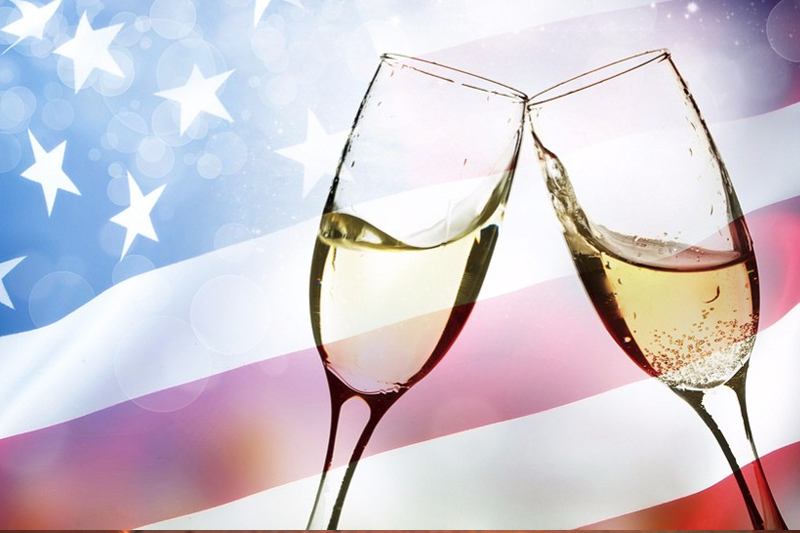Happy Birthday USA. I’m wishing all a wonderful 4th of July extended weekend. Please reflect on all of the positive outcomes that you enjoy due to the Declaration of Independence. This declaration, passed in 1776, resulted in many of the freedoms and responsibilities we enjoy today. While marveling at the fireworks displays, which will be ubiquitous, colorful and spectacular, take a bit of time to reflect on the sacrifice and perilous adventure the writers, signers and colonists undertook to provide for us.
Terrunyo Sauvignon Blanc Block 5 from Casablanca Valley in Chile is made by one of Concha y Toro’s better-known winemakers, Ignacio Recabarren. Concha is a very large company, but it is known for allowing its winemakers great latitude. I am fortunate to be on its list to review wine as it is released, due to the auspices of Creative Palate and my friends there, Kate and Jane. Here’s my read on the new release 2016, 90 points under $23. Pale yellow in the glass with a vibrant bouquet of lime zest, green hay and gooseberries (these can be red or white or mixed, and the white look like very small, pale-ribbed watermelons). On the palate dried grass, citrus melon and jalapeño without the heat (low Scoville unit quotient); proper acid frame carries all through a fairly long finish. These normally score in the 88-90 range.
They can be found under $22 in our area. Be a careful label reader here. There are other Terrunyo SB labels, i.e. Block 27. I have not reviewed them yet. The best recent Block 5 was the 2013. If you see it on a shelf, scoop it up. These will keep four years or so in most cases.
Also from Creative Palate is the new release from Ferraton Pere & Fils of a Rhone white and Rosé.
The Blanc 2016 is 60 percent Grenache and 40 percent Clairette, juices to which far too few of us in the USA are exposed. In the hands of good winemakers, lovely, inexpensive white wine is produced. Ferraton makes an approachable level of red, white and rosé under the generic label Samorens. The Blanc is pale golden with a pretty floral and fruit nose. Decent balance nose to acidity with medium body; 87 points under $14. The Rosé was more appealing to me. Red-pink-orange-colored with a complex nose: peach, melon, floral and citrus aromas repeat on the palate with some apple and mineral nuance, balancing acidity with medium-long peach finish. Don’t drink this too cold. The nose is the thing. Some extra info: their Cote Rotie wines are consistent. I truly enjoy wine from the Roasted Coast of the Rhone. Ferraton L’Eglantine 2009 is perfect now. Tanzer and WS both laid on 92 points.
These came on at $42, surged to $75 and have receded to $46. The 2013 is available at Kreston but is too young and a bit pricey in my opinion.
Fair under $60, I rate it 90, drink from 2019-38. Frontera Chardonnay 1.5 L (did you know this was also named a magnum?) is a decent buy for jug winos. I have seen 6-bottle cases priced under $65. These are a great place to start for those who wish to move on from the lighter, fruity styles so in vogue among my new readers.
While writing about newer readers and drinkers, it occurred to me many are unaware of bottle sizes. So, here you go: The 187.5 ml Piccolo or Split is typically used for a single serving of Champagne. A 375 ml Demi is half the standard 750 ml size, and the 750 ml Standard is the most common bottle size. The 1.5 L or Magnum equals 2 standard 750 ml bottles; the 3.0 L Double Magnum is four standard 750s.
Moving on, the 4.5 L Jeroboam equals six 750s; 6.0 L Imperial, eight 750s; 9.0 L Salmanazar, 12 750s or 1 case; Balthazar, 16 750 ml bottles; and 15.0 L Nebuchadnezzar, 20 750 ml bottles. Many of the larger bottles are collector items. Expect to pay a premium. Also, the larger the bottle, the longer it takes to age the wine within. There may be some controversy here with the advent and wide acceptance of Stelvin process capping. So far, the jury is still sequestered.



























































